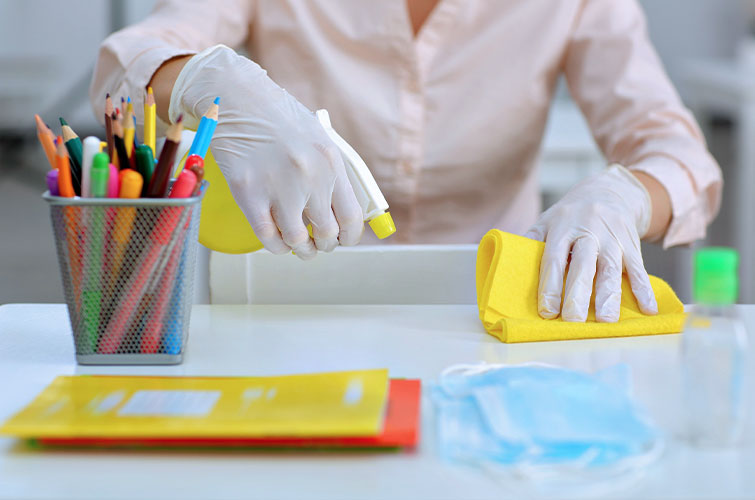Care and Cleaning
This article is broken into two sections, High Pressure Laminate Care, and Dry Erase Laminate Care; to view Dry Erase Markerboard Laminate Care, scroll to bottom of the page.
This article is broken into two sections, High Pressure Laminate Care, and Dry Erase Laminate Care; to view Dry Erase Markerboard Laminate Care, scroll to bottom of the page.

All Allied high-pressure laminates will provide years of beauty and performance when used and cared for properly. This guide offers suggestions and recommendations on care and cleaning techniques to help your laminate surfaces stand the test of time. To view care and cleaning instructions for Dry Erase Laminates, scroll to bottom of page.
**CAUTION** DO NOT use harsh chemicals, abrasive cleansers, scouring pads, sharp writing utensils or other sharp object on high-pressure laminate surfaces. They can be scratched.
General Care and Cleaning Instructions
Routine Surface Cleaning: High-pressure laminates can be easily wiped clean with just a clean, damp cloth or sponge using a mild soap, non-bleach detergent or one of the general-purpose cleaners listed below. Water spots can be removed by using Dow Bathroom Cleaner®. Ammoniated and/or vinegar based glass cleaners are best for cleaning grease soiled surfaces. Polishes, waxes and sealers are not recommended as Allied laminates have their own luster. Application of these products can cause residue buildup.
Allied has tested a variety of general purpose cleaners and found them safe for cleaning all laminates, including: Lestoil® PineSol® Top Job® Dow Bathroom Cleaner® Fantastik® Formula 409® Joy® Crystal Simple Green® Ammoniated or vinegar-based glass cleaners
Allied has not tested all cleaners, and other products may be equally effective. If you use products not listed above, we recommend you review the recommendations and cautions, and test a small area before applying to the entire surface.
Stain Removal Tips
FOOD STAINS: Stains such as tea, food dyes, fruit drinks or coffee may become difficult to remove if not wiped off immediately. Using a liquid cleaner with a short bristle nylon brush is recommended for removing food stains, as well as water marks, rings and greasy fingerprints.
INK STAINS/PENCIL MARKS: Inks from felt tipped pens, textile dyes and printed material (price labels, newspaper, magazines) can transfer to the laminate and become permanent. Remove any ink marks as quickly as possible. If necessary, use full-strength detergent or glass spray cleaner. Allow the cleaner to remain on the stain for several minutes, blot with a damp cloth, then rinse with clean water. If ink stains persist, a solvent such as denatured alcohol, fingernail polish remover (acetone), mineral spirits or paint thinner may be used. Several applications may be needed. Finish with a thorough cleaning and rinse.
CHEMICAL STAINS: High-pressure laminates resist staining from alcohol, paint thinners and most cosmetics. However, some common household products can cause permanent damage, including; bleach, hair dye, rinses, drain cleaners and dishwasher detergent. Protect laminate surfaces from rust remover, metal polish, oven cleaner and toilet bowl cleaners. Spills from acids or caustic products will etch, discolor and permanently damage the laminate if allowed to remain on the surface. Wipe spills immediately and rinse thoroughly.
PAINT & ADHESIVE STAINS: Varnish, lacquer and oil base paints can be removed using appropriate solvents or paint removers. See above cautions when using solvents. Water based paints are best removed with an ammoniated household detergent such as Lestoil®. Super Glue type adhesives (cyanoacrylates) can be removed with nail polish remover (acetone).
General Care
AVOID EXTREME HEAT: Avoid applying extreme heat. Exposure above 150° may result in separation of the laminate from the wood substrate. Do not place hot pans or dishes directly on the laminate. Use a trivet or insulated pad beneath hot objects. Cigarette burns permanently damage laminate surfaces.
AVOID SCRATCHES, ABRASIONS AND CHIPS: High-pressure laminates resist wear and abrasion, but accidental damage can occur in the course of normal use. Heavy ceramic or metal objects with rough surfaces can scratch the laminate surface. Never use knives or sharp implements directly on the laminate. Avoid dropping or striking the surface with hard objects, especially near the edges. Impacts can chip or crack the laminate surface.
With a little sensible care and routine cleaning, your Allied Table will look beautiful for many years to come.

**CAUTION** DO NOT use harsh chemicals, abrasive cleansers, scouring pads, sharp writing utensils or other sharp object on high-pressure laminate surfaces. They can be scratched.
General Care
Your Allied Dry Erase Markerboard Tables have a durable, high-gloss surface that will last for many years of daily use. To clean your writing surface and restore its original luster, simply wipe the entire surface with a soft cloth moistened with warm water or markerboard cleaner, and immediately wipe dry with a clean soft cloth.
Additional Tips
Here is a list of some popular cleaning products:
With a little sensible care and routine cleaning, your Allied Dry Erase surfaces will look beautiful for many years to come.